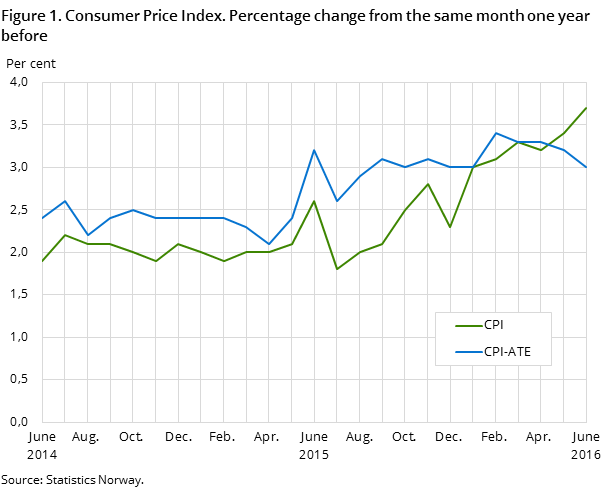Content
Published:
This is an archived release.
CPI up 3.7 per cent in twelve months
The Consumer Price Index (CPI) rose 0.6 per cent from May to June. The year-to-year growth in the CPI was 3.7 per cent in June, up 0.3 percentage points from May.
| Monthly change (per cent) | 12-month rate (per cent) | Index | |
|---|---|---|---|
| May 2016 - June 2016 | June 2015 - June 2016 | June 2016 | |
| CPI All-item index | 0.6 | 3.7 | 145.2 |
| Food and non-alcoholic beverages | 1.0 | 2.3 | 136.8 |
| Housing, water, electricity, gas and other fuels | 0.8 | 5.5 | 177.4 |
| Transport | 0.9 | 1.9 | 157.0 |
| Recreation and culture | 0.9 | 4.7 | 129.0 |
| Clothing and footwear | 0.4 | 5.5 | 57.2 |
| CPI-ATE (July 1999 = 100) | 0.3 | 3.0 | 135.5 |
| CPI by delivery sector | |||
| (December 2014 = 100) | |||
| Consumer goods | 0.7 | 4.4 | 105.8 |
| Services | 0.5 | 2.8 | 104.8 |
| Services where labor dominates | 0.3 | 2.6 | 104.5 |

The year-to-year CPI-ATE growth was 3.0 per cent in June, down 0.2 percentage points from May. The CPI was 145.2 (1998=100) in June 2016, compared to 140.0 in June 2015, which corresponds to a year-to-year growth of 3.7 per cent.
Monthly change: higher prices on food, fuels and electricity
From May to June, the CPI rose 0.6 per cent, partly due to a 1.1 per cent increase in the prices of food. Fruits and vegetables in particular showed price increases. In total, the prices of imported agricultural goods rose 3.0 per cent from May to June. In comparison, prices of Norwegian agricultural goods rose 0.4 per cent in the same period.
Prices of electricity including grid rent usually fall from May to June, but rose 2.8 per cent this year. Further, prices of auto diesel rose 6.7 per cent from May to June, while petrol prices rose 3.3 per cent.
The monthly change in the CPI was mainly dampened by lower prices on furniture and furnishings.
Year-to-year growth: higher electricity prices, lower fuel prices
From June 2015 to June 2016, the CPI grew 3.7 per cent. Higher electricity prices were the largest contributor to the year-to-year growth; prices on electricity including grid rent showed a year-to-year increase of 31 per cent. During the summer of 2015, the prices of electricity fell to a historical low due to heavy rainfall and a late thaw. Combined with this year’s increase in electricity prices from May to June, this had a large impact on the year-to-year growth. The CPI excluding electricity (CPI-AEL) rose 2.9 per cent from June 2015 to June 2016.
The year-to-year growth of the CPI was mainly dampened by lower fuel prices. In spite of the price increase from May to June, petrol and diesel prices were 4.6 and 5.3 per cent lower than the same month last year respectively.
Change in the year-to-year growth: electricity prices pulled the CPI up
The year-to-year growth in the CPI rose from 3.4 per cent in May to 3.7 per cent in June, while the year-to-year growth in the CPI-ATE fell from 3.2 per cent in May to 3.0 per cent in June. The increased growth in the CPI was mainly due to the aforementioned development in electricity prices. Prices of electricity including grid rent rose 2.8 per cent from May to June 2016, but fell 7.7 per cent in the same period last year.
Airfares pulled in the opposite direction, with an increase of 1.9 per cent from May to June this year, compared to an 18.4 per cent increase last year.
On 1 June this year, the air passenger tax was introduced. In the adjusted series it is assumed that the tax burden is immediately and fully passed on to the consumer. In isolation, the air passenger tax pulled the CPI-ATE down by approximately 0.1 percentage points. The remaining 0.1 percentage point decrease is mainly due to the aforementioned development in airfares.
New detailed consumer classification, ECOICOPOpen and readClose
The CPI adopted Eurostat’s new detailed 5-digit consumer classification, ECOICOP in January 2016. Statistics Norway has published unofficial 5 and 6-digit COICOP indices for the consumer group Food and non-alcoholic beverages up until January 2016. As a result of a discrepancy between the unofficial and the new official ECOICOP, some previously published indices are no longer available. This results in new names for some of the published groups.
Contact
-
Statistics Norway's Information Centre
E-mail: informasjon@ssb.no
tel.: (+47) 21 09 46 42
-
Konsumprisindeksen
E-mail: konsumprisindeksen@ssb.no
tel.: (+47) 62 88 56 34
-
Camilla Rochlenge
E-mail: camilla.rochlenge@ssb.no
tel.: (+47) 40 90 23 72
-
Kjersti Nyborg Hov
E-mail: kjersti.nyborg.hov@ssb.no
tel.: (+47) 40 90 23 63
-
Gunnar Larsson
E-mail: gunnar.larsson@ssb.no
tel.: (+47) 40 90 26 79
-
Trym Kristian Økland
E-mail: trym.okland@ssb.no
tel.: (+47) 46 81 09 15
